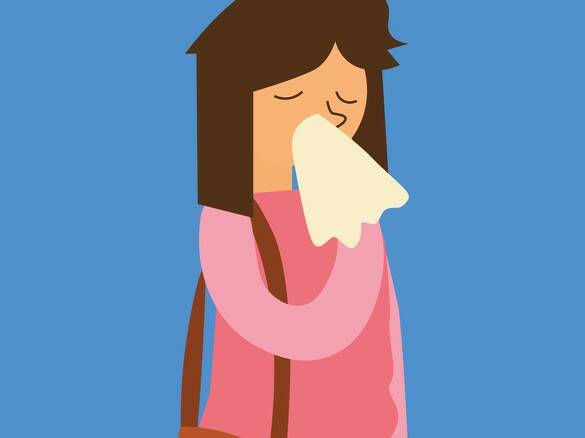Coughing up mucus: what causes it? + Morning coughing and colour

Under normal circumstances, mucus has a protective function. Its increased production is caused by certain diseases. An example of this is infection with viruses or bacteria. In this case, excess mucus must be removed from the airways. And this is what coughing is for.
Coughing up phlegm is associated with a productive or wet cough. This is typical of respiratory diseases, such as infections. Phlegm can be of different colours, for example white, grey, yellow, green. Sometimes there may also be an admixture of blood.
You often ask:
What is behind the morning coughing up of mucus from the bronchial tubes?
How to help better coughing and dissolution of mucus?
Can home treatment and tea help, is syrup needed?
What does the colour of mucus mean, for example green or yellow or whitish?
What is mucus and what is its significance?
Mucus is a secretion of the lining of the respiratory tract. Its main function is protective. It protects the lining of the respiratory tract from the influence of atmospheric air. In addition, it contains substances that fulfill an immune role.
Certain diseases result in its increased production. If there is insufficient expectoration, there is a risk of stagnation (accumulation) in the airways. As a consequence, there is a re-infestation of micro-organisms and also a blockage of the airways.
In this case, the sputum, as the mucus is technically called, must be removed from the airways by coughing, which is actually a defence reflex mechanism and serves to relax the airways. A moist, productive cough should be encouraged.
Unlike a dry cough, which irritates the airways. In addition to irritating them, it makes a person's life uncomfortable. On the other hand, it signifies a disease that needs to be monitored and treated. In this case, medication should be chosen to suppress it.

Drugs for easier expectoration, and thus for better removal of mucus from the airways, are called mucolytics or expectorants.
These drugs, often in the form of syrups, have the effect of better "dissolving" the mucus. This makes it easier to cough it up, and out of the bronchial tubes.
Especially in young children, it is very common to see mucus flowing from the upper airways and from the nasopharynx into the bronchial tubes.
And this is where cough support is important.
The second group are cough suppressants. These are called antitussives.
When choosing a cough medicine, it is important to take advice from a doctor, from an experienced worker in the pharmacy or by reading the package leaflet for the medicine carefully. This way you can avoid using the wrong medicine for the type of cough.
You may also ask about whether home treatment and tea will help. In this case, too, it has its place and justification. However, it cannot completely replace the role of medication.
Examples include the well-known advice on how to cough up phlegm a little more easily. These include lemon water, which is best first thing in the morning, or honey or a combination of the two. This will encourage a morning cough and relax the airways.
Claims of support with ginger, garlic or onions are also well known. Various herbal teas have an additional effect. For these, it is also advisable to consult a pharmacy or doctor.
What causes overproduction of mucus?
One of the causes is upper respiratory tract diseases. They are caused by viruses and are mild in nature. They are characterised by a runny nose, increased body temperature and also a cough. Treatment with mucolytics is not necessary.
Infection of the respiratory system is also caused by influenza. It is an acute infection caused by the RNA virus. It multiplies and penetrates the mucous membranes of the respiratory tract. It causes fatigue, increased temperature, congestion and cough.
Congestion also occurs in sinusitis (inflammation of the sinuses), caused by bacteria and viruses. In addition to rhinitis, there is also mucus leakage into the lower airways and coughing. Mothers know about this when their children cough up mucus (especially during the night hours).
Coughing up mucus from the bronchial tubes in lower respiratory tract diseases is typical. This includes inflammatory diseases of the bronchial tubes and lungs. Acute bronchitis, for example, is very common, and is technically known as bronchitis.

This disease can be acute (caused by viruses or bacteria) or chronic.
Chronic inflammation is long-lasting and often recurs and the reason is environmental influences such as smoking, environmental pollution, poor working environment.
Chronic bronchitis is most common in smokers. It manifests itself as a long-lasting mainly morning cough with morning expectoration of mucus to blood.
It is very important to treat bronchitis in time, as it can lead to chronic obstructive disease.
It is the name for the simultaneous occurrence of chronic bronchitis and emphysema.
It is also a disease of the lower respiratory tract, when there is an obstruction in the lung tissue and problems with breathing. It is this disease that is characterized by a wet cough and also coughing up mucus.
A dangerous condition is pneumonia, which is technically called pneumonia. Mucus is also found in the lungs. In inflammatory diseases, it is formed at an increased rate and its accumulation contributes to the multiplication of microbes. Therefore, coughing is important.
Most often, pneumonia is caused by viruses or bacteria. It is therefore an infectious form, which can have several types. The non-infectious form can also arise from factors in the external environment. Antibiotics are most often chosen for treatment, and corticosteroids for the non-infectious form.
Infectious diseases that manifest on the lungs include tuberculosis. In addition to the lungs, it can affect the kidneys, brain, skin and bones. In the pulmonary form, it typically manifests with fatigue, difficulty breathing and a productive cough along with mucus.
Coughing up mucus also occurs in ascaridosis, which is a relatively common disease caused by a nematode. It is a worm that lives in the small intestine and if its larvae get into the lungs, coughing up mucus, sometimes with blood, occurs.
The colours of the sputum
Sputum is normally colourless. When its production is increased, it is important to notice both the colouration and the smell. A putrid smell is present in purulent diseases and in the breakdown of lung tissue. The colour of sputum may be:
- white, transparent
- yellow
- green
- brown
- pink and foamy
- dark red - mucus with blood
- saffron
- black, blackish grey
Other causes of coughing up mucus include chlamydial infections, aspiration of a foreign body, and coughing up bloody sputum in the case of cancer. If there is any deterioration in health and the problem persists, a specialist examination is recommended. The same is true for coughing up mucus.
Fun but informative video about mucus
Diseases with symptom "Coughing up mucus"
Interesting resources
Related










